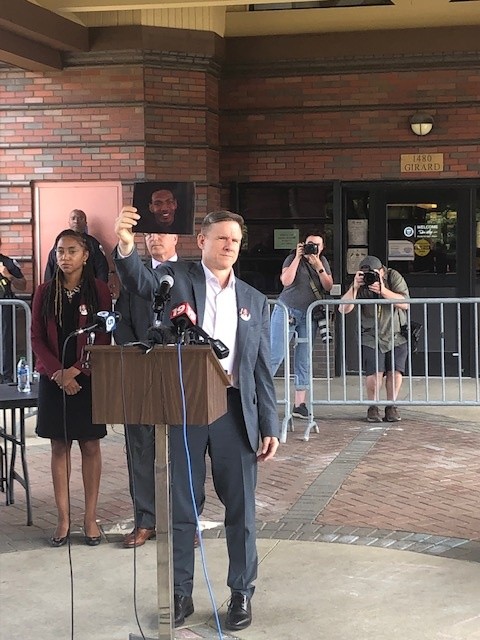The Jayland Walker Shooting Footage is Worse Than You Think
Eight Akron officers fired 90 rounds at an unarmed man.
Eight Akron police officers fired approximately 90 bullets into the body and head of 25-year-old Jayland Walker in a Monday police murder. Walker was unarmed as he exited his vehicle and fled from officers on foot across an Akron parking lot, where he was gunned down after officers "perceived that he posed a deadly threat."
The officers, who are now on paid administrative leave, have released no statements, so it is unknown what threat they perceived. An Akron Police Department Incident report says only that "in response to this threat, officers discharged their firearms, striking the suspect."
The incident is reminiscent of the #137shots case in 2012, in which Cleveland police officers executed Timothy Russell and Malisssa Williams in an East Cleveland parking lot after their backfiring vehicle was mistaken for gunfire.
In Akron, the fusillade of police bullets was the culmination of a crosstown chase as well. It began with an unspecified traffic stop — it has been characterized as an "equipment violation," generally something like a broken tail light — from which Jayland Walker fled, reaching speeds of roughly 80 miles per hour on Route 8. Officers heard a "sound consistent with a gunshot" during the pursuit and reported that shots had been fired. An alleged "muzzle flare" was captured on video.
A handgun and a separate magazine of bullets were recovered from Walker's vehicle after the shooting, but Walker was unarmed when Akron police fired on him, pumping his body full of bullets as he twitched on the asphalt. According to Bobby DiCello, attorney for Jayland Walker and his family, the officers then turned him over, handcuffed him and administered first aid until the arrival of EMS, at which point Walker was pronounced dead. (DiCello scoffed at the idea — as any rational person would — of officers providing life saving care to a person into whom they'd just unloaded the entirety of their magazines.)
Akron officials released bodycam footage of the incident Sunday afternoon, in accordance with an ordinance passed last year that requires the city to release video documentation of police use of deadly force within seven days of an incident.
Mayor Dan Horrigan, Police Chief Steve Mylett and others spoke at a press conference to explain and contextualize two videos: an edited narrative account and the unedited bodycam footage of one of the first officers on scene. All of the responding officers' bodycam footage is available for viewing on YouTube. The content is extremely graphic.
Horrigan and Mylett offered condolences to the family of Jayland Walker, stressed the importance of transparency and accountability and urged patience as the Ohio Bureau of Criminal Investigation and the Attorney General conduct an investigation. They asked residents to reserve judgement until all the facts are known and cautioned the media against spreading misinformation. They also continually uplifted the Walker family and echoed their calls for peaceful protest. (A march and rally at Akron City Hall followed the release of the footage.)
Chief Mylett stressed that numerous questions about the incident remain — he had a number of questions himself, he said, though he also said it would be improper to air them publicly.
These questions are important, surely, but concern details: What was the nature of the initial traffic stop, for example? Where was Walker headed at 12:30 in the morning? Why was he wearing a ski mask? What is the exact number of rounds that officers fired? (90 is an estimate; it could be slightly higher). What is the exact number of bullets that struck Walker? (60 is an estimate; it could be lower or higher based the number of entry and exit wounds). Did Walker actually fire a shot from his vehicle while driving away from police? Or was the sound that officers heard (and the alleged "muzzle flare" captured on video) something else entirely? Did Walker make some sort of motion for his waistband, as officers are now reportedly claiming, that precipitated their deadly force?
But the answers to these questions do not alter the fundamental monstrosity nor the heinous excesses of the event, which anyone who watches the bodycam footage will be able to decipher without the aid of the Bureau of Criminal Investigation.
***
Sign up for Scene's weekly newsletters to get the latest on Cleveland news, things to do and places to eat delivered right to your inbox.


